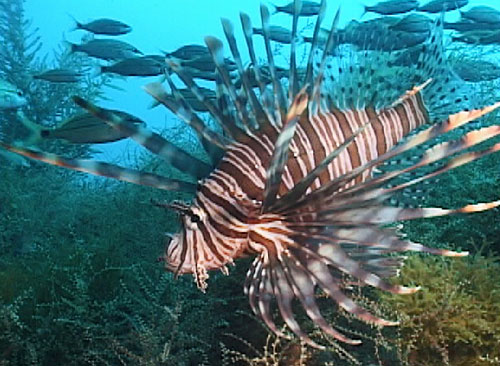InvasiveSpecies
Invasive Species
An invasive species is a non-native species introduced to an area that has an adverse economic, ecologic, or environmental effect on the native ecosystem[1]. Invasive species spread and excel in the ecosystems that they invade because of a lack of competition or a lack of predation from native organisms. In the context of coral reefs, invasive species frequently refers to the lionfish, which is native to the Pacific and is currently invading the Caribbean Sea and Atlantic due to its voracious appetite and lack of natural predators.

Impact
Common examples
Lionfish
Lionfish are any fish of the genus Pterois. They are venomous predatory fish native to the Indo-Pacific region. Two species, Pterois miles and Pterois volitans have established themselves as a significant invasive species in the Caribbean, Gulf of Mexico, and Atlantic Ocean. Lionfish are popular aquarium fish due to their bright warning coloration.
Sightings and Dispersal
Lionfish were most likely introduced into the Caribbean, Gulf of Mexico, and Atlantic Ocean by aquarists. The prevailing theory is that six lionfish were released accidentally into Biscayne Bay due to the destruction of a beachside aquarium by Hurricane Andrew[4]. The current population of lionfish in these areas are likely the descendants of these six fish, along with other lionfish which were released by aquarists, either accidentally or intentionally [4].
Another theory for the appearance of Lionfish in the Caribbean, Gulf of Mexico, and Atlantic Ocean is that at some point in their lifecycle, lionfish were taken into the ballast tanks of ships traversing the Panama Canal from the Pacific side and released in the Atlantic. This theory is generally not given much credence by respected experts.
Appearance and Distribution
Lionfish are commonly found from Florida to Cape Hatteras along the East Coast of the United States. Juveniles have been found further north, though they do not generally survive the cold winter temperatures. They are widespread in the Bahamas, Bermuda, and the Greater Antilles, and the Western Caribbean coasts of Mexico, Belize and Honduras. Sightings have been reported as far south as Colombia, Aruba, and Panama, and as far north as Rhode Island.
Impact on Coral Reef Ecosystems
- Impact on coral reef ecosystems [5] [6]
- Effects on people
- Effects on fisheries [4]
- Explosive populations [7]
- Control and management? [4]
Algae
There are a variety of invasive algae that inhabit Caribbean coral reefs [2].
Amphipods
Some amphipod inhabitants of coral reefs are also invasive [8].
Sponges
There are also some non-native varieties of sea sponges that inhabit coral reef systems [8].
Management Plans
Notes
- ↑ www.oceanservice.noaa.gov/facts/invasive.html
- ↑ 2.0 2.1 2.2 http://www.hawaiicoralreefstrategy.com/index.php/local-action-strategies/aquatic-invasive-species
- ↑ Levin et al. "Community-wide effects of non-indigenous species on temperate rocky reefs." Ecology. Vol. 83: 3182:3193, 2002
- ↑ 4.0 4.1 4.2 4.3 http://coris.noaa.gov/exchanges/lionfish/
- ↑ Albins, Mark A. and Mark A. Hixon. "Invasive Indo-Pacific lionfish Pterois volitans reduce recruitment of Atlantic coral-reef fishes." Mar Ecol Prog Ser. Vol. 367: 233-238. 2008
- ↑ Barbour et al. "Mangrove use by the invasive lionfish Pterois volitans." Mar Ecol Prog Ser. Vol. 401: 291-294. 2010
- ↑ Morris, James A. and John L. Akins. "Feeding ecology of invasive lionfish (Pterois volitans) in the Bahamian archipelago." Environ Biol Fish. Vol. 86: 389:398. 2009
- ↑ 8.0 8.1 8.2 http://www.iucn.org/about/work/programmes/marine/marine_our_work/marine_invasives/seychelles/